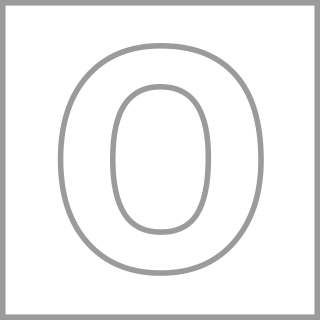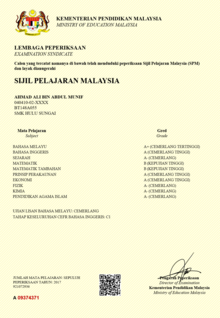Education in Malaysia is overseen by the Ministry of Education. Although education is the responsibility of the Federal Government, each state and federal territory has an Education Department to co-ordinate educational matters in its territory. The main legislation governing education is the Education Act 1996.
An examination board is an organization that sets examinations, is responsible for marking them, and distributes the results. Some are run by governmental entities; some are run as not-for-profit organizations.

A sixth form college is an educational institution, where students aged 16 to 19 study typically for advanced post-school level qualifications such as A Levels, Business and Technology Education Council level 3 (BTEC), and the International Baccalaureate Diploma, or school-level qualifications such as General Certificate of Secondary Education (GCSE) examinations and BTEC level 2 qualifications. In many countries this type of educational institute is known as a junior college. The municipal government of the city of Paris uses the phrase 'sixth form college' as the English name for a lycée.

The Malaysian Higher School Certificate, commonly abbreviated as STPM, is a pre-university examination in Malaysia. It was formerly known as the Higher School Certificate (HSC). Since 1982, STPM has been administered by the Malaysian Examinations Council (MEC), a statutory council under the Ministry of Education.
The Singapore-Cambridge General Certificate of Education Ordinary Level is a GCE Ordinary Level examination held annually in Singapore and is jointly conducted by the Ministry of Education (MOE), Singapore Examinations and Assessment Board (SEAB) and the University of Cambridge Local Examinations Syndicate (UCLES). Students are graded in the bands ranging from A to F and each band has a respective grade point, a lower grade point indicates better performance. The number at the end of each grade corresponds to the grade point that they receive. To pass an individual O-Level subject, a student must score at least C6 or above. The highest grade a student can attain is A1.

Penilaian Menengah Rendah was a Malaysian public examination targeting Malaysian adolescents and young adults between the ages of 13 and 30 years taken by all Form Three high school and college students in both government and private schools throughout the country from independence in 1957 to 2013. It was formerly known as Sijil Rendah Pelajaran. It was set and examined by the Malaysian Examinations Syndicate, an agency under the Ministry of Education.
Sekolah Menengah Kebangsaan Hamid Khan is a secondary school in Island Glades, Penang, Malaysia.
Primary School Achievement Test, also known as Ujian Pencapaian Sekolah Rendah, was a national examination taken by all students in Malaysia at the end of their sixth year in primary school before they leave for secondary school. It is prepared and examined by the Malaysian Examinations Syndicate, an agency that constitutes the Ministry of Education.
In Malaysia, Pendidikan Moral is one of the core subjects in the Sijil Pelajaran Malaysia (SPM) examination. It is a required subject for all non-Muslim students in the public education system in Malaysia. Muslim students are required to take the Islamic Studies course. Pendidikan Moral, along with Islamic Studies, is governed by the Department of Islamic and Moral Studies (JAPIM), a branch under the Ministry of Higher Education.

Sekolah Berasrama Penuh Integrasi Gombak is one of the 70 boarding schools administered by the Sektor Sekolah Berasrama Penuh. Located in Sungai Pusu, Gombak, the school is a few kilometres from the International Islamic University Malaysia (IIUM). This school is known as InteGomb as an abbreviation from its name among SBPs. Sekolah Berasrama Penuh Integrasi Gombak have shown outstanding achievements both academically and in co-curriculum activities. Sekolah Berasrama Penuh Integrasi Gombak have been ranked top 10 among other elite fully residential schools since 2008 in the Sijil Pelajaran Malaysia. In the Sijil Pelajaran Malaysia 2013 examination, the school gained GPS of 1.18 to become the best school in Selangor. The school made a history in the SPM 2020 examination to become the best school in Malaysia with GPS of 1.00 and in SPM 2022 with GPS 1.05

The O-Level is a subject-based qualification conferred as part of the General Certificate of Education. It began in the United Kingdom and has been adopted, often with modifications, in several other countries.
Kolej Yayasan Saad (KYS), formerly known as the Saad Foundation College, was established by Tan Sri Halim Saad as a private, entirely residential institution in 1995. It was built as a tribute to his late father. The school is located in Ayer Keroh, Malacca. In both the Pentaksiran Tingkatan 3 (PT3) and Sijil Pelajaran Malaysia (SPM) exams, the school is popularly known for achieving outstanding outcomes. Additionally, the school is also known for its wide variety of co-curricular activities such as rugby, netball, swimming,triathlon, orchestra and also debate. The school only accepts scholars who demonstrate merit. Students who want to be admitted into this school submit their applications online, where their applications has to go through stringent selection process that takes into account their academic standing, potential for leadership, and extracurricular engagement. Only roughly 100 slots countrywide are available out of about 5000 submissions. about 100 spots are offered for the Form 1 batch yearly. Half of these spots are set aside for scholars from lowly socio-economic environments where they are funded by local GLCs or organisations such as Axiata Foundation and Yayasan Khazanah. The school fee averages at around RM40,000 yearly
Sekolah Menengah Kebangsaan Semera is a five-year comprehensive public secondary school in Semera Village within Asajaya, a small district within Samarahan Division which is in Sarawak, Malaysia. The school is located approximately 10 kilometres southeast of Asajaya.

Sekolah Menengah Kebangsaan Taman Tun Dr. Ismail or SMKTTDI is a secondary school located along Jalan Leong Yew Koh, in Taman Tun Dr. Ismail, a main township in Kuala Lumpur, Malaysia. It was founded in 1980.
Additional Mathematics is a qualification in mathematics, commonly taken by students in high-school. It features a range of problems set out in a different format and wider content to the standard Mathematics at the same level.

Sekolah Menengah Agama Persekutuan Labu or formerly Sekolah Menengah Agama Wilayah Persekutuan (SMAWP) is one of the three federal-funded Islamic Religious secondary boarding schools in Malaysia and is in Labu, one of the small towns in north Seremban, Negeri Sembilan. The school used to be located in Klang (1982) and Petaling Jaya (1983–87), Selangor and named Sekolah Menengah Agama Wilayah Persekutuan, before it moved to Labu in 1987. The school is known as one of the Sekolah Kluster Kecemerlangan and Sekolah Berprestasi Tinggi.
The Malaysian Matriculation Programme is a one year pre-university preparatory programme offered by the Ministry of Education, Malaysia.
Mata Pelajaran Pengajian Umum is a pre-university qualification of general studies for private universities in Malaysia. It was formerly known as Mata Pelajaran Wajib (MPW). The Malaysian Ministry of Education officially announced the new modular system of MPU from 2014 onward. Those who undertake M.Sc or PhD will not be affected and are not required to undertake MPU. The MPU is set and run by Malaysian Examination Council, and examined by Malaysian Examination Syndicate, both of which are under Ministry of Education.
Miri Science Secondary School is a boarding science secondary school located in Miri, a city in the Malaysian state of Sarawak. The current principal is Dayang Laila Haji Kahar.
Education in Brunei is provided or regulated by the Government of Brunei through the Ministry of Education and the Ministry of Religious Affairs. The former manages most of the government and private schools in the country where as the latter specifically administers government schools which provide the ugama or Islamic religious education.










